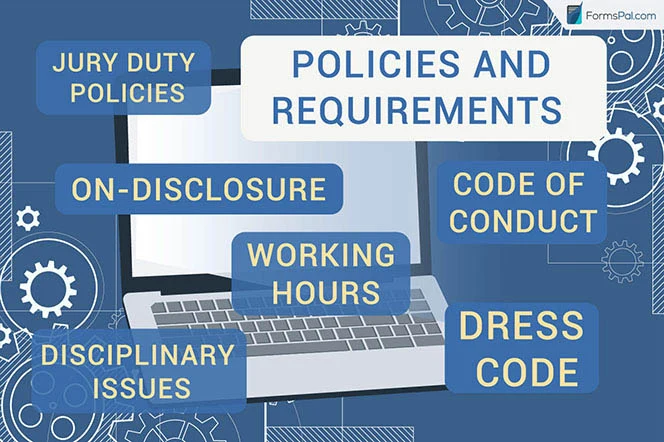Employee Handbook Template
An employee handbook, also known as a staff handbook or employee manual, is a human resources document that outlines the company’s history, values, policies, and mission statement. It allows not only to determine management expectations and working benefits but also to describe an overall organization image. Employee handbooks are usually an integral part of successful businesses, aiming to create a positive company culture.
Although having an employee handbook may sound great, creating one can be quite a challenging task. Crafting a consistent handbook requires a lot of effort and time. Our customizable employee handbook template is here to facilitate your work. However, you should use it as a basis and personalize your handbook as much as possible. You may also search for employee handbook examples to inspire yourself. Do not hesitate to use our step-by-step guidelines, which will lead you to the desired result.
Build Your Document
Answer a few simple questions to make your document in minutes
Save and Print
Save progress and finish on any device, download and print anytime
Sign and Use
Your valid, lawyer-approved document is ready
Why It Is Necessary to Have an Employee Handbook
Employers are not required to provide employee handbooks, but it’s highly encouraged to have one. No matter if you have a big company or a small business, the handbook will set the mood for your workplace and provide successful communication between all organization members. The main benefits of using a staff handbook are the following.
Legal regulation
The handbook is a legal human resources document, and the policies defined there are subject to state laws. Outlining the business policies is important not only for creating a good company culture and quality management process but also to protect your business. Employee manuals should obligatorily describe harassment and discrimination policies and outline an at-will employment clause, explaining that employees are free to resign at any time. All new hires should be required to sign the acknowledgment form, proving that they have read the handbook and are aware of consequences should something go wrong.
Successful communication
Employee handbooks are good mediators between employers and employees. The information described in the handbook gives the hiring employees an understanding of every job-related aspect. Therefore, they can share the company’s vision and work effectively and on a large scale. Staff manuals serve as a welcome for new employees and quickly fill them in about the whole concept of the company’s development. The handbook helps an employee not feel scared on the first day of work and become a part of the team from the first day of employment. All in all, an employee handbook is a great foundation for successful communication between all company members.
Clear expectations and benefits
An employee handbook is a nice means to convey employment expectations and employee benefits. It should clearly outline what the employees can expect in terms of job procedures, paid days off, vacation, overtime compensation, work-at-home, rest breaks hours, bereavement leave, and sick-leave policies. You need to describe performance reviews and promotion conditions and how to reach the highest performance at work. The manual should always contain information about such benefits as health insurance, family medical leave policy, and overtime compensation policy. The manual can help explain to the new employees such unpleasant topics as dress code and code of conduct, as well as drug and alcohol policies.
Positive culture
A strong employee handbook is always understandable. It’s fully personalized and reflects the workplace unique culture. That is why the handbook should start from the beginning and describe the company’s history and mission. A staff handbook is both an introduction for hiring employees and a reminder for the employees who have already worked in the company for a long period of time. It unites everyone within an inner circle, which is an important part of the workplace culture you should strive to create.
What to Include in an Employee Handbook
While there are no regulations on how the employee handbook should be structured and what information is necessary to include in it, you are still expected to cover some important sections, such as:
- History and mission
It isn’t easy to imagine the company’s description without mentioning its history. It’s crucial to let your new employees know how your company has been created, everything it’s been through so far, and how it has reached the current point. If the company is quite popular, everyone may know this information. However, a big part of history can still be hidden, and your new employees would be happy to see what’s behind the curtain. Besides, it creates an inner circle and unites everyone.
- Core values
Like the company’s history, its values and vision are also important to mention. Your new employees should know where your company is moving to and what principles it is governed by. Try not to be too general, naming such popular variants as “integrity” or “excellence,” but rather determine what you really value in your employees, giving an example to each stated value.
- Employee requirements and policies
The next step is to describe how your policies reflect your values. Here, you need to include information related to management structure, code of conduct, anti-harassment and non-discrimination policies, time off policies, including paid time off, holidays, vacation, and sick-leaves. In the information age, it’s crucial to define social media, mobile, and internet usage policies and confidentiality criteria. You should also identify the jury duty policy and disciplinary proceedings.
- Promotions and development opportunities
Your hiring employees need to know all about working hours and job salaries. One of the important things to mention is whether there are possibilities for promotion and, if yes, what are the conditions and requirements. Make sure to include job benefits the employees will get, including health insurance and retirement plans. These things will serve as an additional motivation for the high performance of the employees.
- Office rules
It would be nice (and in some companies crucial) to outline the office rules and expected workplace behavior. The new hires should know how different departments interact and what areas can be restricted for them to enter. You need to indicate the security requirements and safety tips. Many companies also define equipment and resources the hiring employees can take advantage of. It’s never redundant to clarify lunch time rules.
- Disclaimers
The handbook should clearly indicate that any of its statements do not create a contract but provides general guidelines for employees. Therefore, you should not include any specific steps on how to manage this or that situation. Also, employee handbooks should contain disclaimers about possible policy changes and how they will be informed.
What Makes a Great Employee Handbook
The above-mentioned information is probably included in all employee handbooks. Still, the point is to shape your unique style and focus on those things, which differentiate you from everyone else. Your employee handbook can be very simple or highly detailed—it’s all up to you and your team. Whatever design you choose, make sure it fully complies with your company’s core values, virtues, and mission statement. If you do not know where to start, look for some popular employee handbook examples. You are also encouraged to consider the following information when creating your handbook.
Be fully aware of who you are
Not knowing clearly who you are and what you do will make your handbook look faceless and, as a result, boring and useless. You need to be fully aware of your mission to communicate a company culture successfully. Show off your unique brand. Believe in what you do and what you strive for. It will inspire your employees to support your values and expectations.
Be creative
To be really useful, your employee handbook should be understandable and engaging. Long texts with convoluted jargon and no visuals will make it boring to read. That’s why you should consider using pictures and graphics along with some anecdotes and practical examples. Such a tone will draw your new employees’ attention and help them feel less stressed on their first day at work.
Be professional
While you are encouraged to approach the task creatively, do not forget that an employee handbook is still a document, and you are required to include certain company policies and requirements. They are required to protect the employer’s interest and comply with state laws.
When preparing your employee handbook, you can search popular companies’ handbooks and use them as inspiration. For example, Netflix’s Employee Culture Guide is quite simple but clearly outlines all aspects of its culture. Another great example is a handbook of the Valve video game developer company. Its handbook for new hires will be interesting to read even for a mere stranger. The handbook includes everything from illustrated history to anecdotes and jokes, and even a glossary of code words. If your company is too serious for such humorous content, take the Ford Code of Conduct Handbook as an example. It combines all the corporate policies and directives, but its structure makes it still easy-to-understand and interesting to read.
How to Write an Employee Handbook
Employee handbooks can be long and include a large volume of information. But still, it’s your duty to approach the writing process thoroughly. Our customizable employee handbook template is aimed at making the task as easy as possible for you. However, please do not use the bare template as a ready manual; it’s necessary to adapt it to your company. The following steps will help you in your creating process.
Step 1. Make a plan

To accomplish great things, it’s necessary to have a plan. It would be useful to define the sections you want to cover in your handbook before the writing process. It will help you to structure the information and not to forget any significant statement. With the plan, you will get some kind of table of content and be fully ready to write the manual.
Step 2. Use your imagination

The second important stage of the creating process is to personalize the information and decide on the design. You are allowed to use images and illustrations (if appropriate), as well as graphics and anecdotes. Try to find some good employee handbook examples and templates to inspire yourself. Make your handbook look interesting and unique, using the power of your imagination. Do not limit yourself to bare templates.
Step 3. Begin with an introduction

Many companies underestimate the introduction section of the handbook. But a well-structured document always has an introduction, main body, and conclusion. You can use a welcome for new hires as an introduction. You can also begin the handbook with your company’s story and mission. Whatever you choose, the introduction section has to be captivating.
Step 4. Describe the policies and requirements

The main part of all employee handbooks is related to company policies, procedures, and requirements. This part can be divided into several sections, covering different information. One section may cover everything related to the organization process and rules, including non-disclosure, code of conduct, dress code, working hours, jury duty policies, lunch hours, and disciplinary issues. This section can also outline the security requirements, safety tips, social media policy, and internet usage regulations. You should also include an at-will employment clause, explaining the voluntary termination of employment by employees.
Another section should be devoted to employee benefits, including insurance and vacation policies, paid days off, performance reviews, and promotion conditions. Additionally, it can contain sick-leave and bereavement leave statement. Certain policies must be included in any employee handbook, such as family health leave policies, non-discrimination, non-harassment, and different compensation policies. You have to check local requirements every time you write, review, or change the handbook. Your employment lawyer should review the handbook and make sure it complies with all necessary regulations.
Step 5. Add acknowledgment form

Your new employees must sign the acknowledgment form, proving that they have read the employee handbook and understand the company policies. Once signed, a copy of their signature should be saved. If the employee refuses to sign the form, you should request a written refusal to protect your company’s interest.
Remember that nobody can create your employee handbook better than you. It’s that type of documentation that requires your personal contribution. Use the templates wisely, and do not create the employee handbook only for the record. When you have your manual ready, do not hand it over to the employees without saying a word. Try to instruct them and be open to every question they might have. It is important to periodically review the handbook, improving this or that statement according to laws or work changes.
Frequently Asked Questions
Do I Have to Sign the Employee Handbook?
Yes, you do. The employee handbook is a legal human resources document regulating the company’s policies and procedures. It usually requires a lot of time and effort to be created, and if the employees do not read it, the document becomes useless. Additionally, your signature marks that you have received the handbook and are familiarized with its terms. If you refuse to sign the handbook’s acknowledgment form, your employer may request you to give a written refusal to protect the company’s interest.
Does a Startup Need an Employee Handbook?
An employee handbook may seem unnecessary when you have a small business. However, it’s a common misconception. Recording core values and policy can be quite useful even for a startup. The most important thing for a small business is shaping the culture and its way of development. The handbook can help create your business’s overall idea and present it to your employees (even if you are hiring only one of them). Moreover, an employee handbook can become for a startup a guide and motivation to keep moving on. So, it’s worth considering such an option.
How Often Should an Employee Handbook Be Updated?
The best indicator of a successful business is its consistent and continuous development. Time changes and every company must catch up, especially in their field of activity. As a general rule, you should review and update your employee manual once a year. However, there is no limitation, and you can update it as soon as your company faces changes. Note that you have to notify your employees after each change in the handbook and request them to sign the acknowledgment form again.
What Is the Difference Between an Employee Handbook and an Employment Agreement?
An employee handbook is not the same as an employment agreement. The employment agreement is a specific contract for just one individual, while employee handbooks usually come as supplements to employment contracts. The main differences between these documents are:
- Employment agreements are legally binding contracts. They outline the parties’ legal obligations and responsibilities and are regulated by the labor laws. Employment handbooks, in their turn, contain company policy and general tips for employees within a workplace. The handbooks are not themselves subject to state laws, but the policies are.
- Employment agreements are adapted individually to each employee, while the handbooks apply to all workers and have general guidelines about, for example, work from home or vacation.
- Employers cannot change the employment contract without the employee’s consent, while they can independently review and change employee handbooks at any time.
- Employment handbooks contain both strict issues and recommended procedures, while employment agreements contain only strict, legally binding obligations and responsibilities.
